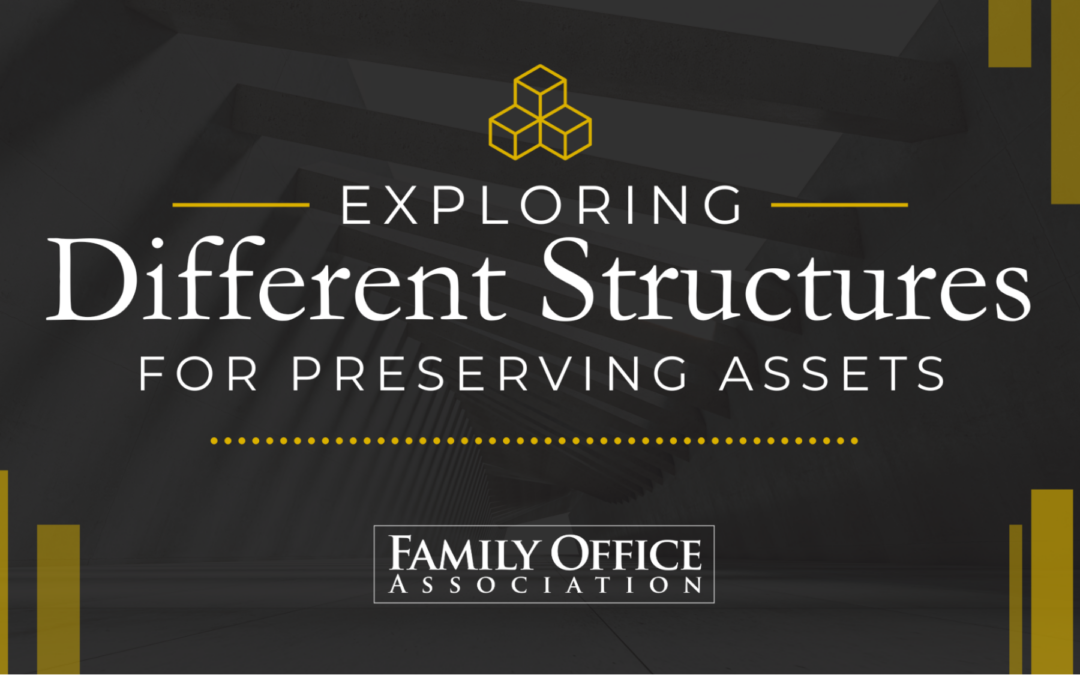Family Office Association (FOA) welcomes you to our weekly Blog, dedicated to our members and the greater family office community seeking education and insight into the ever-changing family office landscape.
In the vast landscape of wealth management and preservation, families have a myriad of structures at their disposal to safeguard their assets for future generations. Each structure has its own advantages, considerations, and legal and tax implications, making it crucial for families to carefully evaluate and select the one that aligns with their specific goals and circumstances.
A Trust
One commonly utilized structure is the trust. A trust allows individuals, known as trustees, to hold and manage assets on behalf of beneficiaries. Trusts offer multiple benefits, including asset protection, tax planning, and control over wealth distribution. By establishing a trust, families can ensure their assets are shielded from potential creditors or other external threats while maintaining control over how and when those assets are distributed to future generations.
Various types of trusts cater to specific needs. Revocable living trusts are flexible and allow the grantor to retain control and make changes during their lifetime. Upon the grantor’s death, the trust becomes irrevocable, providing asset protection and privacy while facilitating the seamless transfer of assets. Irrevocable trusts, however, provide stronger asset protection, albeit with limited control for the grantor. These trusts are commonly used to minimize estate taxes and protect assets from legal challenges.
A Family Investment Company or Limited Partnership
Another option for asset preservation is establishing a family investment company (FIC) or a family limited partnership (FLP). These structures provide families with vehicles to consolidate their assets and maintain control over their investments. By pooling resources, families can enjoy greater economies at scale, negotiate favorable terms with investment managers, and enhance their ability to make strategic investment decisions. Additionally, these structures can facilitate the seamless transfer of wealth to future generations while potentially mitigating tax liabilities.
Family investment companies are established as private limited companies, allowing family members to hold shares in the company. The directors of the FIC can be chosen from within the family itself. This structure offers advantages such as centralized control, easier transferability of shares, and potential tax benefits like reduced inheritance tax due to the exemption for business assets. On the other hand, family limited partnerships function with family members acting as general and limited partners. The structure allows for centralized management and control by the general partner while providing limited liability and tax advantages.
Holding Companies
A family holding company may be a suitable structure for asset preservation for families with operating businesses. A holding company allows families to centralize the ownership and control of multiple businesses, thereby simplifying management and protecting the value of these enterprises. By separating the ownership of the operating company from the family’s personal assets, the holding company can shield the family’s wealth from potential business risks while allowing for shared ownership and control.
A holding company offers additional benefits such as improved governance, consolidated tax planning, and succession planning. By transferring ownership of the operating business to the holding company, families can structure their heirs in a manner that allows for controlled management and a smooth transition to the next generation. This structure also enables efficient intergenerational wealth transfer, asset protection, and the possibility of attracting external investors to fuel future growth.
The Philanthropic Option
In some instances, families may opt for philanthropic structures to both preserve their assets and make a positive impact on society. Setting up a family foundation or a donor-advised fund allows families to engage in charitable giving while simultaneously achieving their wealth preservation objectives. By establishing clearly defined guidelines and strategies, families can ensure that their philanthropic efforts align with their values and create a lasting legacy that extends beyond generations.
Family foundations are dedicated to carrying out charitable activities by providing grants and funding to charitable organizations or directly undertaking charitable projects. These foundations offer families the opportunity to pass on their values and create a lasting impact on causes they care about. Donor-advised funds, on the other hand, provide families with flexibility and control over their charitable giving. Families establish the fund, contribute assets, and then advise the fund on distributing donations to eligible charities, allowing for a more personalized and targeted approach to philanthropy.
Acknowledging that each structure comes with its own complexities and legal considerations is crucial. To navigate these challenges effectively, families should seek the guidance of legal and financial professionals who are well-versed in wealth preservation. Furthermore, regular review and adjustment of the chosen structure may be necessary as circumstances change or new opportunities arise. Exploring different structures for preserving assets requires careful consideration and a deep understanding of a family’s unique dynamics, aspirations, and long-term goals. By selecting the most appropriate structure, families can ensure the long-term preservation of their wealth, protect their assets from potential risks, and create a solid foundation for future generations to build upon. The expertise, advice, and collaboration of professionals in the field greatly enhance the effectiveness and success of these structures, enabling families to navigate the complex landscape of wealth preservation with confidence, clarity, and a sense of legacy. If you have further questions or wish to enhance your family office, contact the team at Family Office Association.

